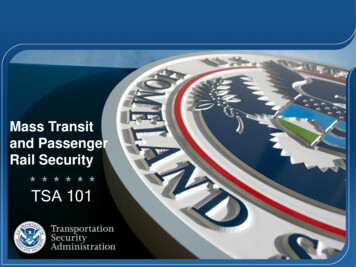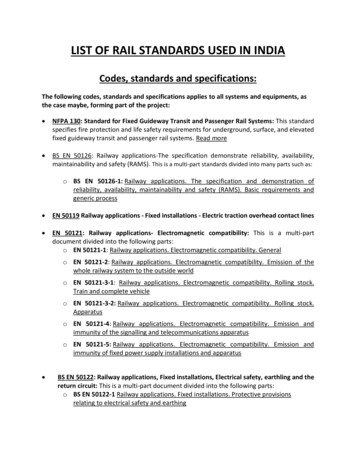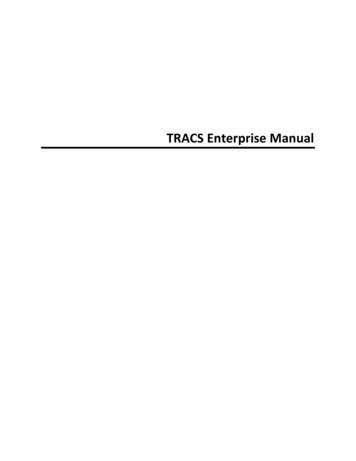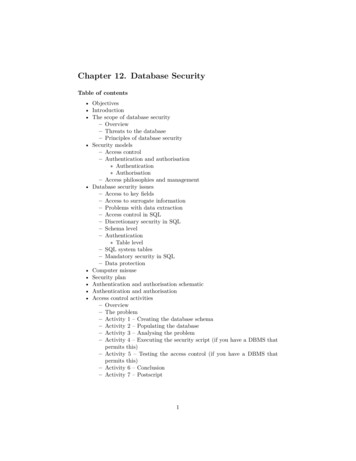
Transcription
Mass Transitand PassengerRail SecurityTSA 101
TSA Background TSA was created in the aftermath of 9/11 tooversee security for all transportation systems. Federalization of security operations wascompleted by the end of 2002. TSA became part of the Department of HomelandSecurity in March 2003, making up a quarter ofthe DHS workforce. TSA’s Mission: Protect the nation's transportationsystems to ensure freedom of movement forpeople and commerce. TSA’s scope includes commercial and generalaviation; mass transit systems; freight andpassenger rail; highways; pipelines; andmaritime.This presentation focuses on TSA’sprograms and initiatives in the MassTransit and Passenger Rail (MTPR)modes of transportation.
TSA Strategic Approach Intel-driven, risk-based approach. Multi-faceted security systems. Unpredictable visible securitymeasures. Security conscious transportationworkforce. Cutting-edge technology. Engage stakeholders indeveloping security programsand activities.
Strategic Priorities For Surface TransportationPlanningThe National Strategy forTransportation Securityidentifies seven priorities keyto surface transportationsecurity. TSA works withtransportation operators toimplement and improveprograms that address eachof these eterrenceCriticalInfrastructureProtection
Seven Risk-Based PrioritiesBaseline-state security plans; Contingency plans;Recovery Plans; Special Event plansPlanningSecurity Awareness training; situational training;job briefings; task-specific trainingTrainingTabletop, situational drills and full-scale exercisesExercisesTwo-way information sharing informs all of thesecurity prioritiesInformation &Intelligence SharingOperational activities that reduce risk throughvulnerability mitigation and inspectionOperational Detection and DeterrenceHardening of critical assets along with detection anddeterrence countermeasuresCritical InfrastructureProtectionOutreach and education for customers, passengers,emergency responders and law enforcementCommunity Outreach
MTPR by the Numbers Approximately 6,800 local transit providers, providing over 28 million trips daily andover 10 billion trips annually. Amtrak and Alaska Railroad provide the nation’s only long-distance passenger rail;Amtrak carried 31.3 million passengers in fiscal year (FY) 2016 Types of MTPR services include:– Commuter rail– Heavy rail (subways and metros)– Light rail (trolleys and streetcars)– Long-distance rail (Amtrak and Alaska Railroad)– Monorail– Cable cars– Inclined planes (funiculars)– Automated guideway systems– Intracity buses– Demand response servicesINSERT MODALSPECIFIC PHOTOHERE
Key Areas of Emphasis for MTPRSecurity ObjectiveHigh risk public transit and passenger rail systems, measured by ridership,infrastructure, and area of operation.Risk Profile Public transportation systems face significant challenges in making theirsystems secure. Certain characteristics make them both vulnerable anddifficult to secure.– MTPR systems typically have fixed, publicly accessible transitschedules– The high ridership of some systems makes them attractive targets forterrorists but also makes certain security measures, like metaldetectors, impractical. These systems are difficult to protect due to open infrastructure, highconcentration of travelers, and multiple access areas with limitedinspection and control points. Risks increase in urban areas due to the convergence of multipletransportation systems and the higher densities of travelers at intermodalterminals.
Threat LandscapeThe MTPR sector continues to be an attractive target ofterrorists and criminals overseas.Risk Scenarios––––––Sabotage to infrastructure causing derailment;Armed assault and active-shooter situations;Cyber-attack;IEDs aboard a train/in a station/on a platform;Insider threat; andChemical/biological attack.
Key Programs and InitiativesPlanning TSA works with security leaders in the industry to identify risks anddevelop plans to enhance security, preparedness and resiliency fromterrorist attacks. Planning also addresses measures that can be put in place in theevent of heightened states of alert or for imminent threats. TSA’s Baseline Assessment for Security Enhancement (BASE)program is designed to assess transit system’s voluntaryimplementation of TSA recommended security program consisting of17 Security Action Items– Allows agencies to track their progress against security goalsover time.
Key Programs and InitiativesTraining TSA provides a variety of materials to enhance frontlineemployee awareness and understanding of potential securitythreats:– TSA has developed MTPR-specific Counterterrorism Guides forfrontline employees. Cyber Security Resources Toolkit– Cyber Security Counterterrorism Guide– Cyber Security Resources Toolkit– TSA First Observer Plus Program provides transportationprofessionals with the knowledge needed to recognize suspiciousactivity possibly related to terrorism, guidance in assessing what theysee, and a method for reporting those observations. TSA encourages MTPR operators to make securityawareness training a regular component of new employeetraining and recurrent training for seasoned employees.
Key Programs and InitiativesExercises Intermodal Security Training and Exercise Program (I-STEP)– Provides exercise, training, security planning tools, and servicesto the transportation community.– Focuses on the security nexus of the intermodal transportationenvironment.– MTPR does approximately 10 a year Exercise Information System (EXIS) Tool to help operators andconduct their own exercises
Key Programs and InitiativesInformation and Intelligence Sharing TSA shares intelligence and security-related information with theMTPR industry nsit Policing and Security Peer Advisor Group Monthly Conference CallsIndustry-Wide Monthly Conference CallsEvent-driven Conference CallsTransit Security RoundtableSecurity Awareness MessagesTSA-Sponsored Clearance ProgramInformation Sharing and Analysis Centers TSA Office of Intelligence and Analysis develops modal threatassessments each year and provides periodic bulletins or noticesabout security threats on an as needed basis.
Key Programs and InitiativesOperational Detection and Deterrence Transit Security Grant Program (TSGP) Visible Intermodal Prevention and Response (VIPR) Teams Regional Alliance Including Local, State And Federal Efforts(RAILSAFE) Surface Transportation Cybersecurity Workshops
Key Programs and InitiativesCritical Infrastructure Protection Critical infrastructure can be both physical (bridges,tunnels) or cyber (data control centers, trainoperations). TSA has worked with critical infrastructure owners andoperators to determine vulnerabilities and identifyresources to develop operational and technologicalsolutions to minimize those vulnerabilities. R&D activities – test beds .
Key Programs and InitiativesCommunity Outreach TSA works with transportation operators toensure that customers, passengers, emergencyresponders, and law enforcement arecollaborating and communicating to enhancetransportation security. Communication and engagement with both those that use thetransportation system and those charged with protecting it are key todetecting, deterring, and responding to acts of terrorism. Campaigns like “If You See Something, Say Something ” and Not onMy Shift have proven benefits towards detecting potential terroristincidents.
For Further InformationContact TSA Mass Transit and Passenger Rail:tsa.masstransit@tsa.dhs.govVisit TSA.gov ransportation
Amtrak and Alaska Railroad provide the nation’s only long-distance passenger rail; Amtrak carried 31.3 million passengers in fiscal year (FY) 2016 Types of MTPR services include: – Commuter rail – Heavy rail (subways and metros) – Light rail (trolleys and streetcars) – Long-distance rail










